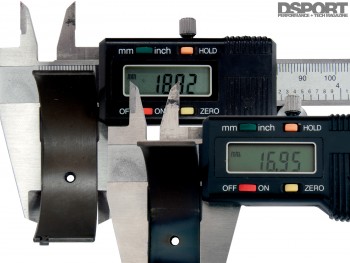Ovals and Oil
While we’ve already covered the basic function of the bearings, it’s important to understand how a bearing’s performance is qualified. First, the dimensions and geometry of a bearing must not only have a sufficient amount of crush (sprung interference between the steel shell and the journal) to keep it in place, it must also establish an ideal shape (eccentricity) around the main or rod pin of the crankshaft. Almost all high performance bearings are engineered to have a high degree of crush. As for the geometry, the bearing’s eccentricity establishes a slight oval around the pin.  This oval shape is engineered to be shorter in the areas where the largest forces will be transmitted. If you measure a bearing you’ll notice it’s thickest in the center of it’s C shape while it gets gradually thinner to within about 7mm of the parting line. From that point, the bearing tends to get considerably thinner (0.001-0.002”). The eccentricity form the center of the bearing to the 7mm mark provides a proper oval while the additional thinness near the parting line accommodates offsets in the caps if the rods or main journals were not properly machined. When under tension, the oval will distort to more of a round shape. This oval shape not only avoids metal-to-metal contact under extreme loading, it also induces the hydrodynamic state of oil flow between the moving parts. In this desirable state, pins don’t touch bearings and no wear occurs. Speaking of wear, an entire field of science called Tribology is dedicated to the engineering of interacting surfaces in relative motion. This science applies principles of friction, lubrication and wear in order to design systems that minimize friction, optimize lubrication and reduce wear.
This oval shape is engineered to be shorter in the areas where the largest forces will be transmitted. If you measure a bearing you’ll notice it’s thickest in the center of it’s C shape while it gets gradually thinner to within about 7mm of the parting line. From that point, the bearing tends to get considerably thinner (0.001-0.002”). The eccentricity form the center of the bearing to the 7mm mark provides a proper oval while the additional thinness near the parting line accommodates offsets in the caps if the rods or main journals were not properly machined. When under tension, the oval will distort to more of a round shape. This oval shape not only avoids metal-to-metal contact under extreme loading, it also induces the hydrodynamic state of oil flow between the moving parts. In this desirable state, pins don’t touch bearings and no wear occurs. Speaking of wear, an entire field of science called Tribology is dedicated to the engineering of interacting surfaces in relative motion. This science applies principles of friction, lubrication and wear in order to design systems that minimize friction, optimize lubrication and reduce wear.
 New bearing shells will usually protrude out of the housing by about 0.001- 0.002” on each end.
New bearing shells will usually protrude out of the housing by about 0.001- 0.002” on each end.
Getting Stressed
Today’s engines are putting out more power per liter than ever before. Put one of these engines in the hands of an informed DSPORT reader and its power output may be doubled, tripled or even six times the original output with the right upgrades. Inside the engine, rods are put under more tension and compressive forces than ever before while crankshafts need to resist the urge to drop out of the bottom of the block.
 The extra length in the bearing shell induces a “crush” that exerts a radial pressure on the housing to keep the bearing in place.
The extra length in the bearing shell induces a “crush” that exerts a radial pressure on the housing to keep the bearing in place.
Tortoise and the Babbitt
Tortoises are known for a hard exterior shell while rabbits (rhymes with babbitt) are know for soft fur. A high-performance engine bearing needs to be both hard and soft in all the right places. To survive under higher stress while not crushing under load requires a “hard” bearing material. The harder materials can keep dimensional stability better for improved wear resistance and load carrying capacity. These hard materials are found in the backing and intermediate layers. Unfortunately, “hard” bearing materials do not allow for the bearing to conform to its housing or embed the hard particles. Instead, “soft” bearing materials (found in the overlay or “babbitt” layer) can provide the conformability and embedability that “hard” materials cannot. All bearings face this hard versus soft balancing act in order to deliver a lifetime of reliable performance. Bearings must also be engineered to resist the chemicals in the oil (including the fuel that will often contaminate the oil).




